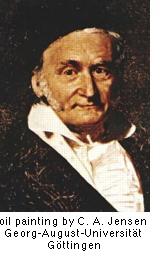Calr Friedrich Gauß (Gauss)
Mathematician, b. 30 April 1777 (Brunswick (Brunswick), Germany), d. 23 February 1855 (Göttingen (Hannover), Germany).
 Carl Friedrich Gauß was the only son of poor peasants. His extraordinary ability in mathematics led his primary school teachers and his supportive mother to approach the Duke of Brunswick, who then financed his secondary schooling and university studies.
Carl Friedrich Gauß was the only son of poor peasants. His extraordinary ability in mathematics led his primary school teachers and his supportive mother to approach the Duke of Brunswick, who then financed his secondary schooling and university studies.
Gauß was a prodigy. He made all his fundamental mathematical discoveries before he turned 18. In 1799 he received his doctorate in absentia for a dissertation that provided the proof, which had eluded mathematicians before, that all algebraic equations with complex coefficients have complex solutions. Two years later, at the age of 24, he published the Disquisitiones Arithmeticae, a work on number theory that is considered "one of the most brilliant achievements in mathematics" (Reichardt, 1995).
In 1801 an asteroid later named Ceres was observed for 40 days before it was lost from view, and astronomers claimed that the data were insufficient to determine its orbit. Gauß obtained three observations, which were sufficient for him to develop a technique for the calculation. His result allowed astronomers to relocate Ceres later in 1801 and again in 1802. In 1807 Gauß was appointed professor of astronomy at the University of Göttingen, having previously declined an offer from St. Petersburg, where he was already a corresponding member of the Academy of Sciences. He stayed in Göttingen for the rest of his life.
By about 1820 Gauß began studies of the shape of the Earth. He invented a superior instrument for surveying and developed the theory of the distribution of errors in measurements fundamental to modern statistics and now known as the "Gaussian curve" or "normal distribution."
Gauß was one of the first to explore the limits of Euclidean geometry. One of Euclid's axioms (fundamental assumptions) was the "parallel axiom" that through any point only one line can be drawn that is parallel to a line not going through the point. Mathematicians had suspected for a long time that the parallel axiom is a consequence of Euclid's other axioms and is thus not required as a separate axiom to underpin his geometry. Gauß studied the question again and came to the conclusion that there actually is a fully consistent geometry that is free of contradictions but does not satisfy the Euclidean axioms.
The existence of a Non-Euclidean geometry* was against all mathematical teaching of the time, and Gauß kept his ideas to himself. Around 1830 János Bolyai in Hungary and Nikolay Lobachevsky in Russia came to similar conclusions, which gave Gauß the courage to say that he had had these ideas already thirty years earlier. His work on special complex functions suffered a similar fate; it had to be reconstructed by other mathematicians from his notes after his death.
From 1830 Gauß collaborated with the physicist Wilhelm Weber, who studied terrestrial magnetism and was involved in the organization of a worldwide observational network. Gauß himself was rather conservative and not enthused about the new age of worldwide communications through telegraphy; but access to the observational network stimulated him to develop the theory of the potential, a powerful means of describing fields of forces in gravitation, electricity and magnetism.
Although known mainly in the field of mathematics, Gauß ranks among the greatest scientists of all times. Publication of his Collected Works began in 1863, eight years after his death, and continued until 1933. His theory of curved surfaces, developed further by his student Bernhard Riemann, forms the mathematical basis of relativity theory.
Reference
Reichardt, H. (1995) Carl Friedrich Gauss, Encyclopaedia Britannica 15th ed.
* In a Non-Euclidean geometry parallel straight lines meet at extremley large distance, and lines that never meet are not straight. The proof whether we live in a Non-Euclidean or Euclidean universe requires observations over extremely large distances and is thus difficult. Mathematically both geometries are equally valid.
home
 Carl Friedrich Gauß was the only son of poor peasants. His extraordinary ability in mathematics led his primary school teachers and his supportive mother to approach the Duke of Brunswick, who then financed his secondary schooling and university studies.
Carl Friedrich Gauß was the only son of poor peasants. His extraordinary ability in mathematics led his primary school teachers and his supportive mother to approach the Duke of Brunswick, who then financed his secondary schooling and university studies.